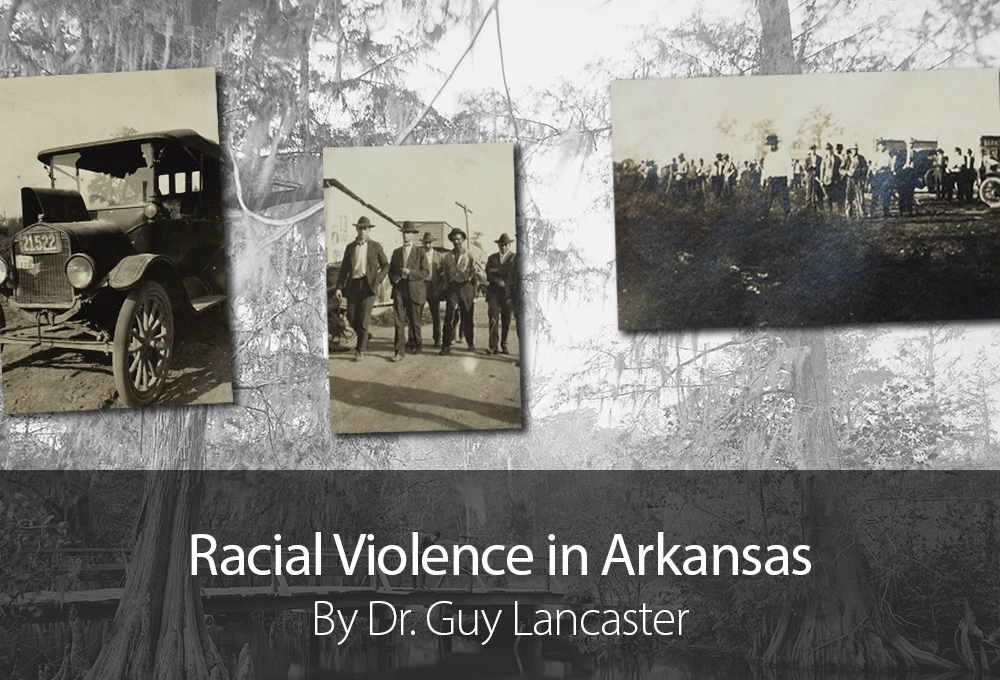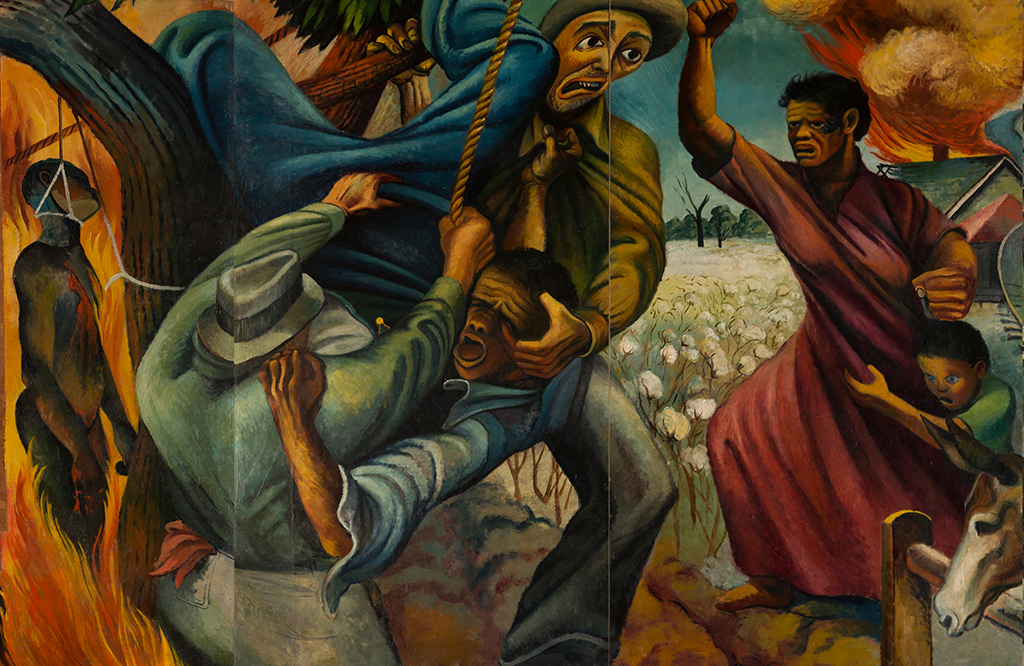Outside of the violence inherent in slavery, the prison system, and other such institutions, racial violence in Arkansas tends to fall into four overlapping categories: lynching, race riots, nightriding/whitecapping, and racial cleansing.
The first lynching occurred in Arkansas in August 1836, about two months after Arkansas formally became a state. A man named Bunch, apparently a free black man in Chicot County, attempted to vote and reportedly assaulted a white man when denied this opportunity. Locals hanged him in response. Several slaves were also lynched during the antebellum years, typically for attempted escape, murder of slave-owners, or other forms of resistance. During Reconstruction, black political and economic life flourished, but these trends were reversed during the 1880s and 1890s. Likewise, lynching increased during these years and became more explicitly racialized. Too, lynching by mass mobs numbering in the hundreds or thousands also became more common in the 1890s and early 1900s. Such mobs burned Ed Coy alive in Texarkana in 1892, shot Wade Thomas to death in Jonesboro in 1920, and dragged John Carter’s lifeless body through the streets of Little Rock in 1927. Depending upon the definition of lynching employed, the deadliest mass lynching in America may have occurred in March 1904 in St. Charles, Arkansas, where thirteen African Americans were killed over three days. The last lynching in the state happened on April 29, 1936, when Willie Kees was murdered in Poinsett County. Approximately 365 lynchings occurred during this century of Arkansas history.
Many mass mob lynchings easily fall into the category of race riots, too, although race riots differ in that the target is not a specific person or specific people but, instead, an entire community. Along the Howard and Hempstead County line in 1883, a boundary dispute between two black farmers and one white sharecropper turned violent, and rumors swiftly spread among whites that African Americans were leading an insurrection. In response, hastily formed white posses attacked black merchants and farmers. Political tensions among black Republicans and white Democrats (the latter eager to regain power following Reconstruction) resulted in riots in Crittenden County in 1888 and St. Francis County the following year, by which whites solidified their hold on power. Economics, too, could provide the catalyst for anti-black violence. An attempted strike by black cotton pickers in Lee County in 1891 was ruthlessly suppressed by local white authorities, who murdered a number of the strikers, setting a bloody precedent for the Elaine Massacre of 1919.
Nightriding (also called whitecapping), as it was practiced against African Americans, typically consisted of the posting of notices, verbal warnings, or physical harassment employed to drive African Americans from jobs or land they occupied. In Black Rock in January 1894, unknown vigilantes posted notices warning black residents to leave town within ten days. Although no violence occurred, about one-third of the black workforce of 300 did leave. In Mississippi County in 1915, a vigilante group attempted to drive black farm laborers from their residences and jobs. These men, however, were swiftly arrested, tried, and sentenced to time in prison, while members of lynch mobs, who did not so directly threaten the profits of white employers, were rarely if ever punished.
Timber, railroad, and mining regions were especially prone to racial cleansing, or the removal of entire black communities, creating what are called “sundown towns” due to reports of signs at town’s edge warning African Americans to be gone by sundown. Harrison, where two expulsive riots occurred in 1905 and 1909, is the most well-known example of a sundown town, but there are many more. White citizens of Cotter expelled its black community in 1906, while Paragould witnessed a series of anti-black riots over several years before solidifying its status as a sundown town. Racial cleansing often overlaps with nightriding/whitecapping, as exemplified by the case of Bonanza, a coal mining town, in 1904. There, white miners organized to demand that local black miners “leave town” before violence broke out, continuing for several days before the last African American was forced out.
Racial violence has had an intergenerational effect upon the lives of Arkansans. Victims of lynching and riots often left behind spouses and children forced to fend for themselves. Those driven from jobs or from the land they owned were left all the more impoverished. And those communities that witnessed racial cleansing remain predominately white today. These violent events may lie in the past, but the effect lives on.
Header Image: Brough, Charles Hillman Collection, Arkansas State Archives, Little Rock, Arkansas; Detroit Publishing Company Photograph Collection, Library of Congress.
For More Information
Barnes, Kenneth C.. Who Killed John Clayton? Political Violence and the Emergence of the New South, 1861-1893. Durham, NC: Duke University Press, 1998.
Buckelew, Richard. "Racial Violence in Arkansas: Lynchings and Mob Rule, 1860-1930." Ph.D diss., University of Arkansas, 1999.
Encyclopedia of Arkansas History & Culture. http://www.encyclopediaofarkansas.net/
Finley, Randy. From Slavery to Uncertain Freedom: The Freedmen’s Bureau in Arkansas, 1865–68. Fayetteville: University of Arkansas Press, 1996.
Froelich, Jacqueline, and David Zimmerman. “Total Eclipse: The Destruction of the African American Community of Harrison, Arkansas, in 1905 and 1909.” Arkansas Historical Quarterly 58 (Summer 1999): 131–159.
Graves, John William. Town and Country: Race Relations in an Urban-Rural Context, Arkansas, 1865–1905. Fayetteville: University of Arkansas Press, 1990.
Hill, Karlos. Beyond the Rope: The Impact of Lynching on Black Culture and Memory. New York: Cambridge University Press, 2016.
Jaspin, Elliot. Buried in the Bitter Waters: The Hidden History of Racial Cleansing in America. New York: Basic Books, 2007.
Lancaster, Guy. Racial Cleansing in Arkansas, 1883–1924: Politics, Land, Labor, and Criminality. Lanham, MD: Lexington Books, 2014.
Lancaster, Guy, ed. Bullets and Fire: Lynching and Authority in Arkansas, 1840–1950. Fayetteville: University of Arkansas Press, 2018.
The Elaine Massacre and Arkansas: A Century of Atrocity and Resistance, 1819–1919. Little Rock: Butler Center Books, 2018.
Loewen, James W. Sundown Towns: A Hidden Dimension of American Racism. New York: The New Press, 2005.
Stockley, Grif. Blood in Their Eyes: The Elaine Race Massacres of 1919. Fayetteville: University of Arkansas Press, 2001.
Stockley, Grif. Ruled by Race: Black/White Relations in Arkansas from Slavery to the Present. Fayetteville: University of Arkansas Press, 2009.
Whayne, Jeannie M. A New Plantation South: Land, Labor, and Federal Favor in Twentieth-Century Arkansas. Charlottesville: University of Virginia Press, 1996.
Woodruff, Nan Elizabeth. American Congo: The African American Freedom Struggle in the Delta. Cambridge and London: Harvard University Press, 2003.
About the Author
Dr. Guy Lancaster is the editor of the online Encyclopedia of Arkansas History & Culture, a project of the Butler Center for Arkansas Studies at the Central Arkansas Library System, as well as an adjunct professor at the University of Arkansas Clinton School of Public Service. He is the author or editor of three books on racial violence in Arkansas.

